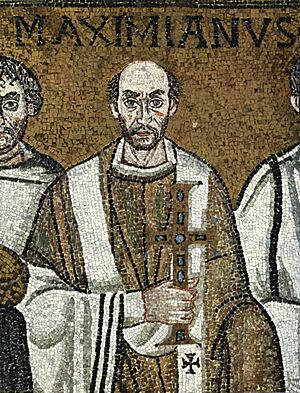Maximianus of Ravenna facts for kids
Quick facts for kids SaintMaximianus |
|
|---|---|

Detail of Maximian in San Vitale, Ravenna
|
|
| Archbishop of Ravenna | |
| Born | 499 Pula, Ostrogothic Kingdom |
| Died | 556 (aged 57) Ravenna, Exarchate of Ravenna |
| Venerated in | Roman Catholic Church Eastern Orthodox Church |
| Feast | February 21 (East) February 22 (West) |
Maximianus of Ravenna, also known as Maximian, was an important church leader in Italy. He was the Bishop of Ravenna from 546 to 556 AD. At that time, Ravenna was the capital city for the Byzantine Empire in Italy. This meant Maximian had a very important role, even helping with some government tasks.
Maximian was born around 499 AD in a place called Istria. He became Bishop of Ravenna because Emperor Justinian I chose him. You can see his image in a famous mosaic inside the Church of San Vitale. This mosaic shows Emperor Justinian and his group. Maximian was known for his strong dedication to the church. He helped finish building the Church of San Vitale. He also had a special ivory chair, called the Throne of Maximian.
A bronze censer from Emperor Justinian's time is a valuable item. A censer is a special container used in church to burn incense. This censer shows how rich and spiritually strong the Byzantine Empire was. Its beautiful design and bronze material show the great skill of artists from that time. This censer, along with the mosaics in San Vitale, reminds us of the amazing history of Christianity in the Byzantine Empire.
Contents
Life of Maximian: Bishop of Ravenna
Maximian was born in 499 AD in a town called Vistar, near Pula in modern-day Croatia. In 546 AD, Pope Vigilius made him the bishop of Ravenna. Maximian was 48 years old and a deacon (a church helper) when he became the 26th bishop of Ravenna.
At first, the people of Ravenna did not want Maximian as their leader. This was because Emperor Justinian had chosen him, not the people themselves. However, Maximian was very clever and good at politics. He managed to win over the people. He earned their respect by being wise, generous, and by starting many big projects to build and decorate churches.
Building Churches and Creating Art
Maximian played a huge part in finishing two major churches in Ravenna: the Basilica of San Vitale and Sant'Apollinare in Classe. He also built other churches, like Santa Maria del Canneto in his home region of Istria.
Maximian worked hard to improve church books and to correct the Latin version of the Bible. He also asked artists to create many beautiful illustrated manuscripts. For the main altar in Ravenna, he ordered a special hanging made of expensive cloth. This cloth showed the entire life story of Jesus. He also had another hanging made with portraits of all the bishops who came before him, embroidered on a gold background.
The Throne of Maximian
One of Maximian's most famous church items is his bishop's chair, known as the Throne of Maximian. This special chair was made entirely from ivory panels. It was likely carved in Constantinople (the capital of the Byzantine Empire) and then sent to Ravenna. The throne has beautiful flower designs and pictures, including a complex symbol of Maximian's name.
Maximian in Mosaics
You can see Maximian in a famous 6th-century mosaic in the Church of San Vitale. His name is written above his figure. In the mosaic, he stands with Emperor Justinian and his group. Maximian is holding a jeweled cross. He is wearing early versions of church clothes, like an alb, a chasuble, and a pallium.
Maximian is considered a saint by both the Catholic and Orthodox churches. He is especially honored in Ravenna, where a church is named after him.
Gallery




